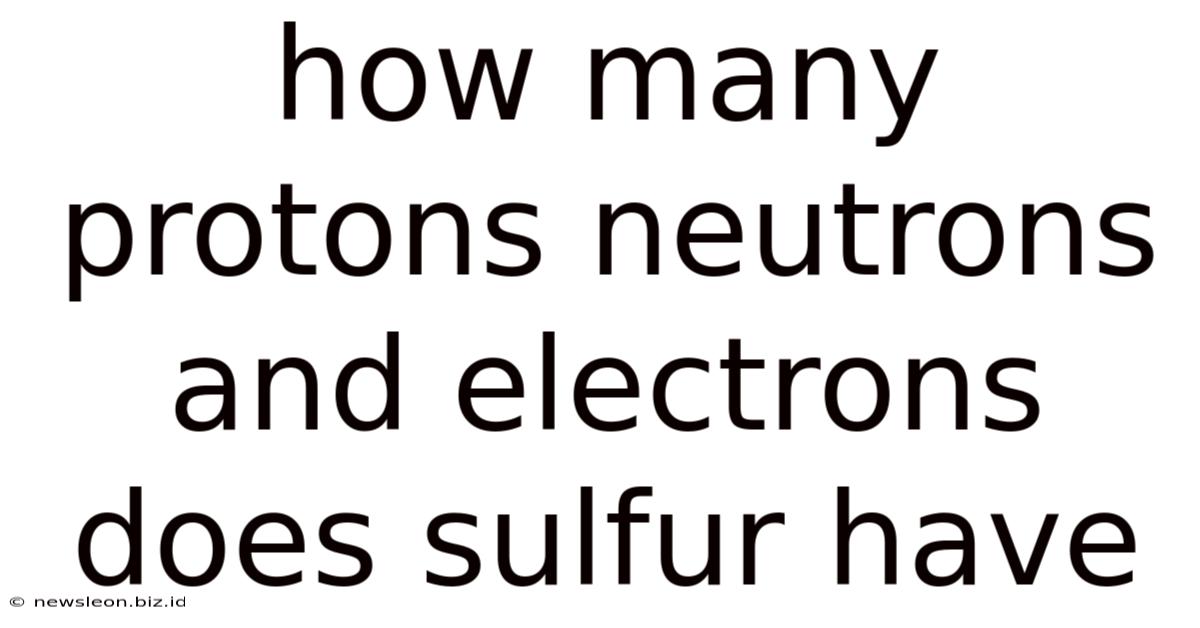How Many Protons Neutrons And Electrons Does Sulfur Have
News Leon
May 04, 2025 · 5 min read

Table of Contents
How Many Protons, Neutrons, and Electrons Does Sulfur Have? A Deep Dive into Atomic Structure
Sulfur, a vibrant yellow element crucial to life and industry, holds a fascinating place in the periodic table. Understanding its atomic structure, specifically the number of protons, neutrons, and electrons, is key to comprehending its chemical behavior and diverse applications. This comprehensive guide will delve into the intricacies of sulfur's atomic composition, explore isotopic variations, and discuss the implications of its electron configuration.
Understanding Atomic Structure: The Building Blocks of Matter
Before we delve into the specifics of sulfur, let's establish a foundational understanding of atomic structure. Atoms, the fundamental building blocks of all matter, are composed of three primary subatomic particles:
-
Protons: Positively charged particles located within the atom's nucleus. The number of protons defines an element's atomic number and determines its identity. No two elements have the same number of protons.
-
Neutrons: Neutrally charged particles residing in the nucleus alongside protons. Neutrons contribute to the atom's mass but not its charge. The number of neutrons can vary within an element, leading to isotopes.
-
Electrons: Negatively charged particles orbiting the nucleus in energy levels or shells. Electrons are significantly lighter than protons and neutrons. The number of electrons in a neutral atom is equal to the number of protons.
The arrangement of these particles dictates an element's properties and how it interacts with other elements.
Sulfur's Atomic Structure: Unveiling the Numbers
Sulfur (S), with its atomic number of 16, possesses 16 protons in its nucleus. This fundamental fact defines sulfur as sulfur – it is the defining characteristic of the element. This positive charge in the nucleus is balanced by 16 electrons orbiting the nucleus in various energy levels, resulting in a neutral atom.
The number of neutrons, however, is slightly more complex. Sulfur has several isotopes, meaning atoms with the same number of protons but varying numbers of neutrons. The most common isotope, Sulfur-32 (³²S), contains 16 neutrons. This is the most abundant isotope, accounting for approximately 95% of naturally occurring sulfur.
Other significant isotopes include:
- Sulfur-33 (³³S): Contains 17 neutrons.
- Sulfur-34 (³⁴S): Contains 18 neutrons.
- Sulfur-36 (³⁶S): Contains 20 neutrons.
While less abundant than Sulfur-32, these isotopes still play a role in the overall properties and applications of sulfur. The weighted average of the atomic masses of these isotopes gives sulfur its standard atomic weight of approximately 32.06 atomic mass units (amu).
Electron Configuration: Understanding Sulfur's Reactivity
The arrangement of electrons in sulfur's energy levels (electron configuration) dictates its chemical behavior and reactivity. Sulfur's electron configuration is 1s²2s²2p⁶3s²3p⁴. This means:
- Shell 1 (n=1): Contains 2 electrons (1s²)
- Shell 2 (n=2): Contains 8 electrons (2s²2p⁶)
- Shell 3 (n=3): Contains 6 electrons (3s²3p⁴)
The outermost shell (valence shell) is the third shell, containing 6 electrons. Atoms strive for a stable electron configuration, often achieving this by having a full outer shell (usually 8 electrons, following the octet rule). Sulfur, with its 6 valence electrons, readily gains two electrons to complete its octet, forming a stable sulfide ion (S²⁻). This tendency to gain electrons makes sulfur highly reactive, readily forming ionic compounds with metals and covalent compounds with non-metals.
Isotopes of Sulfur: A Closer Look at Variations
The existence of sulfur isotopes has significant implications for various scientific fields. The different isotopes of sulfur have subtle differences in mass, which impacts their physical properties. However, their chemical properties remain largely the same, as the number of protons (and hence, the number of electrons) remains constant.
The relative abundances of different sulfur isotopes can be used as tracers in various scientific studies. For example, the isotopic ratios of sulfur in geological samples can provide insights into the formation and age of rocks and minerals. These isotopic signatures are also employed in environmental studies to track pollution sources and understand biogeochemical cycles.
Radioactive isotopes of sulfur, although not naturally occurring in significant amounts, are used in scientific research and medical applications. These isotopes emit radiation, which can be tracked and monitored. This property is utilized in various techniques such as radioisotope tracing in biological systems and medical imaging.
The Significance of Sulfur in Biological and Industrial Processes
Sulfur's unique atomic structure and chemical properties underlie its crucial role in various biological and industrial processes:
-
Biological Systems: Sulfur is an essential element for life. It is a constituent of amino acids (methionine and cysteine), proteins, and enzymes, playing a critical role in protein structure and function. Sulfur-containing compounds also participate in vital metabolic processes.
-
Industrial Applications: Sulfur is widely used in the production of sulfuric acid, a key industrial chemical used in the manufacturing of fertilizers, detergents, and numerous other products. Elemental sulfur is also employed in the vulcanization of rubber, enhancing its durability and elasticity. Additionally, sulfur compounds find applications in the production of matches, pesticides, and pharmaceuticals.
Conclusion: The Importance of Understanding Atomic Structure
Understanding the number of protons, neutrons, and electrons in sulfur, coupled with its electron configuration and isotopic variations, is essential for grasping its chemical behavior and its profound influence on various aspects of our lives. From its biological significance in living organisms to its extensive industrial applications, sulfur's unique atomic structure underpins its diverse roles in the natural world and human society. Further exploration into the intricacies of atomic structure opens doors to deeper understanding of the elements and their crucial impact on our environment and technology.
Latest Posts
Related Post
Thank you for visiting our website which covers about How Many Protons Neutrons And Electrons Does Sulfur Have . We hope the information provided has been useful to you. Feel free to contact us if you have any questions or need further assistance. See you next time and don't miss to bookmark.